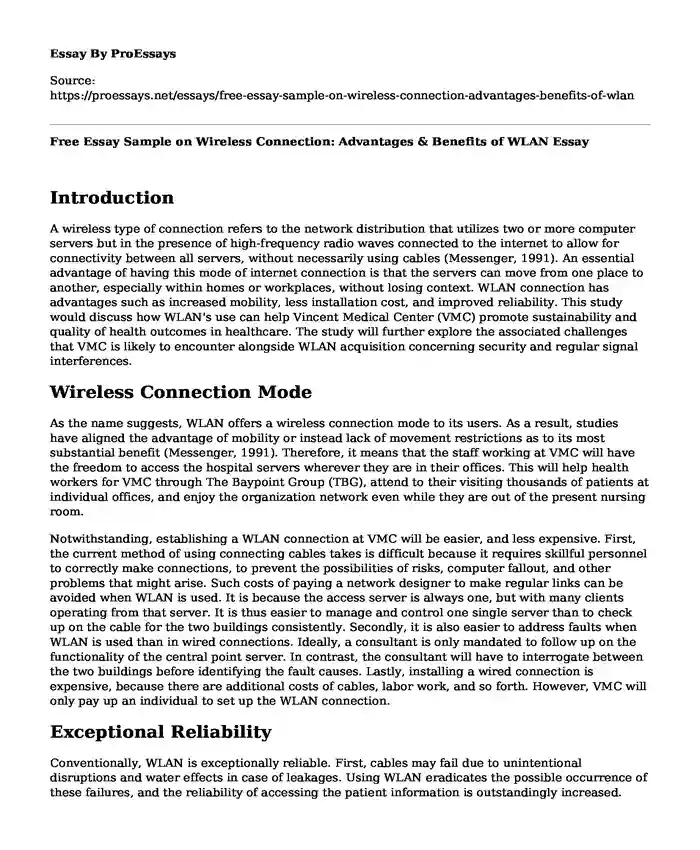Introduction
A wireless type of connection refers to the network distribution that utilizes two or more computer servers but in the presence of high-frequency radio waves connected to the internet to allow for connectivity between all servers, without necessarily using cables (Messenger, 1991). An essential advantage of having this mode of internet connection is that the servers can move from one place to another, especially within homes or workplaces, without losing context. WLAN connection has advantages such as increased mobility, less installation cost, and improved reliability. This study would discuss how WLAN's use can help Vincent Medical Center (VMC) promote sustainability and quality of health outcomes in healthcare. The study will further explore the associated challenges that VMC is likely to encounter alongside WLAN acquisition concerning security and regular signal interferences.
Wireless Connection Mode
As the name suggests, WLAN offers a wireless connection mode to its users. As a result, studies have aligned the advantage of mobility or instead lack of movement restrictions as to its most substantial benefit (Messenger, 1991). Therefore, it means that the staff working at VMC will have the freedom to access the hospital servers wherever they are in their offices. This will help health workers for VMC through The Baypoint Group (TBG), attend to their visiting thousands of patients at individual offices, and enjoy the organization network even while they are out of the present nursing room.
Notwithstanding, establishing a WLAN connection at VMC will be easier, and less expensive. First, the current method of using connecting cables takes is difficult because it requires skillful personnel to correctly make connections, to prevent the possibilities of risks, computer fallout, and other problems that might arise. Such costs of paying a network designer to make regular links can be avoided when WLAN is used. It is because the access server is always one, but with many clients operating from that server. It is thus easier to manage and control one single server than to check up on the cable for the two buildings consistently. Secondly, it is also easier to address faults when WLAN is used than in wired connections. Ideally, a consultant is only mandated to follow up on the functionality of the central point server. In contrast, the consultant will have to interrogate between the two buildings before identifying the fault causes. Lastly, installing a wired connection is expensive, because there are additional costs of cables, labor work, and so forth. However, VMC will only pay up an individual to set up the WLAN connection.
Exceptional Reliability
Conventionally, WLAN is exceptionally reliable. First, cables may fail due to unintentional disruptions and water effects in case of leakages. Using WLAN eradicates the possible occurrence of these failures, and the reliability of accessing the patient information is outstandingly increased. Besides, more patients can be attended to since more than one health worker can have access to the organization's site at the same time, while wired connection only requires one worker at the nursing room at a particular time.
Nonetheless, WLAN is also characterized by some drawbacks that must be taken into consideration if the outlined benefits are to prevail. For instance, shifting from wired to wireless connection would mean that possibilities of radio signal interference come in. In the connection media, most devices usually emit radio signals to their receivers to allow for cyclic and smooth operation (Budin et al., 1994). However, these signals can sometimes be excess of what is designed for their linked receivers, thus causing interference. High operating devices like theft protection systems and photocopiers are examples of elements that could emit radio signals that cause interference. The central drawback of this fault is that it causes failure in data transmission and connectivity. Besides, there is a likelihood that one flaw will stop the operations of the entire VMC because WLAN often operates using a single-stationed operating server. Identifying the point of error and eliminating might equally be costly, as it is the case with wired.
Conclusion
Moreover, there are risks of data security when dealing with WLAN. It is possible because an intruder or hacker might interfere with the connection system, by introducing malware, spam messages, and viruses into the respective devices before engaging in the information breach (Hassinen, 2006). Such is difficult when using cables because the organizational information is centralized within. However, WLAN makes the information decentralized, as it is available online, hence patient data and other medical records stored online become at a higher risk of a potential breach.
References
Budin, D., Herman, A., & Lanzl, C. (1994). U.S. Patent No. 5,276,703. Washington, DC: U.S. Patent and Trademark Office.
https://patents.google.com/patent/US5276703A/en.
Hassinen, T. (2006). Overview of WLAN security. In Seminar on Network Security (Vol. 11, No. 12). https://dl.irstu.com/wp-content/uploads/Download/Education/Book/Network/Network%20Security/WEP-WPA-Article/Overview%20of%20WLAN%20security.pdf.
Messenger, S. (1991). U.S. Patent No. 5,046,066. Washington, DC: U.S. Patent and Trademark Office. https://patents.google.com/patent/US5046066A/en.
Cite this page
Free Essay Sample on Wireless Connection: Advantages & Benefits of WLAN. (2023, Nov 01). Retrieved from https://proessays.net/essays/free-essay-sample-on-wireless-connection-advantages-benefits-of-wlan
If you are the original author of this essay and no longer wish to have it published on the ProEssays website, please click below to request its removal:
- Essay Sample on Impacts of Technology on Computer Networking
- The Future of Cyber Warfare - Paper Example
- Research Paper Example on Cloud Technologies
- Research Paper on Transition of Bookkeeping From Paper to Electronic Data
- Data Classification: Labels, Tags and Accessibility - Essay Sample
- Essay Example on Harold Innis & Applying His Concepts to the Internet
- Cloud Migration: Moving Data, Apps, and IT Processes - Essay Sample







